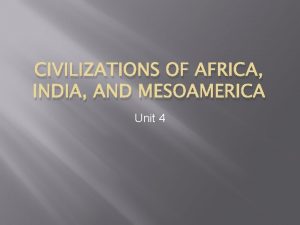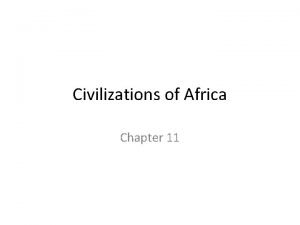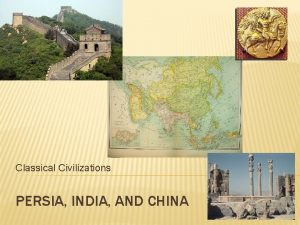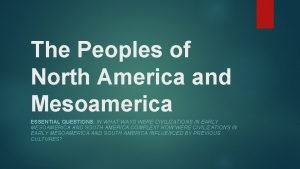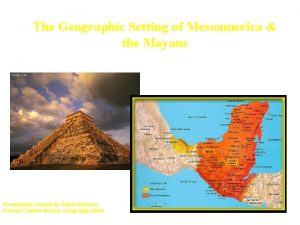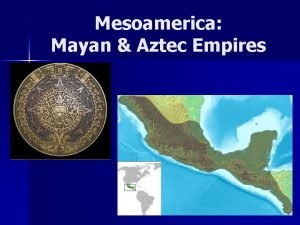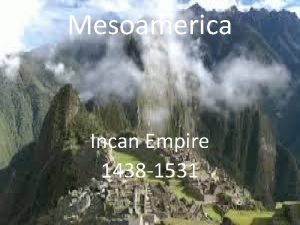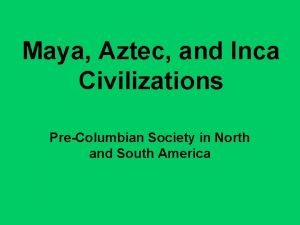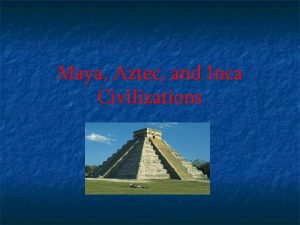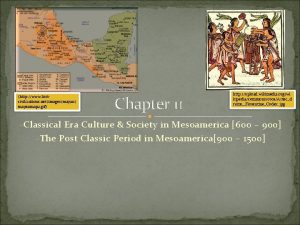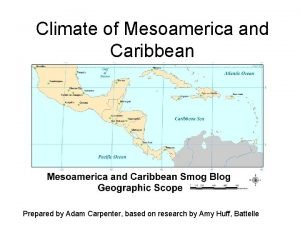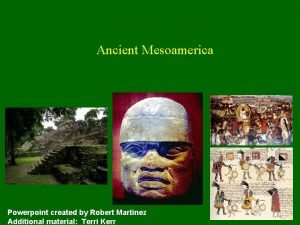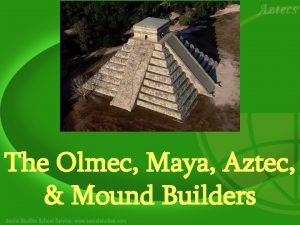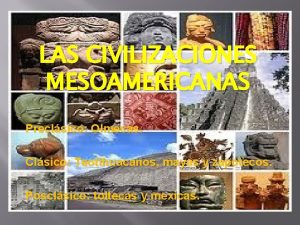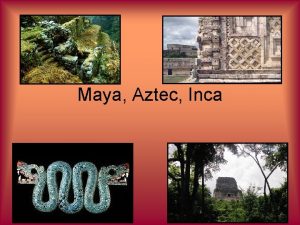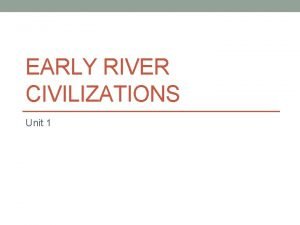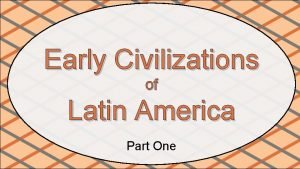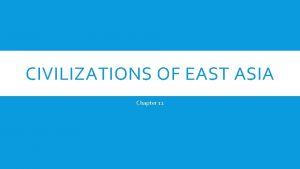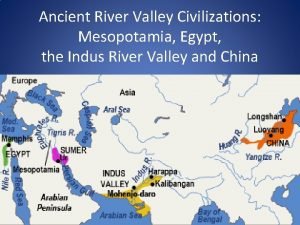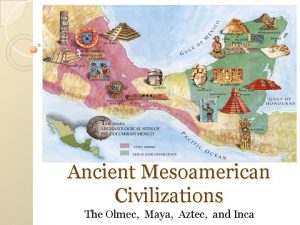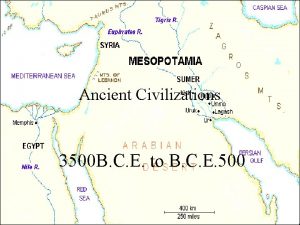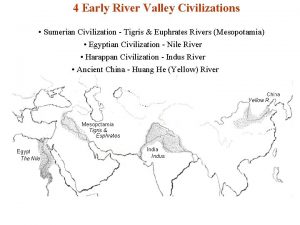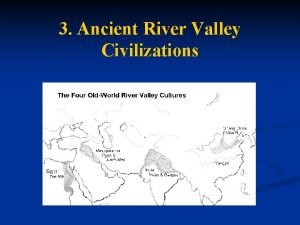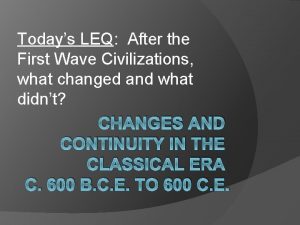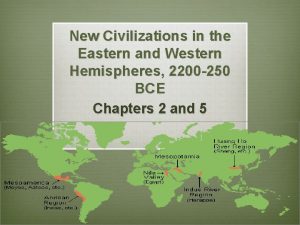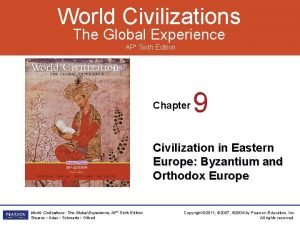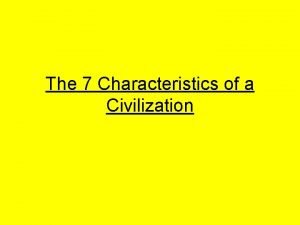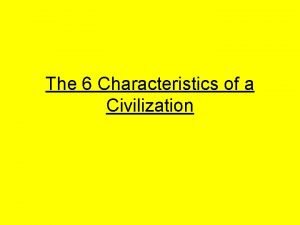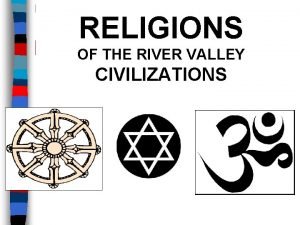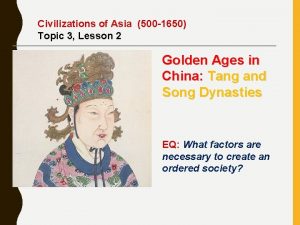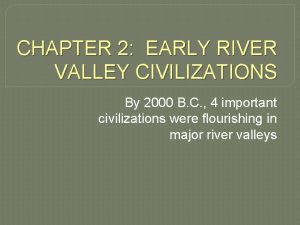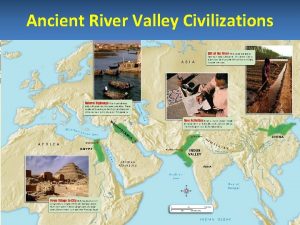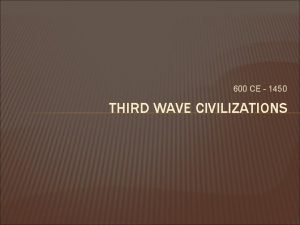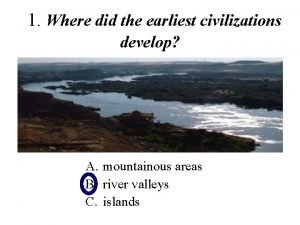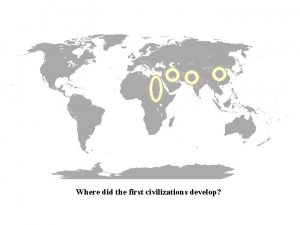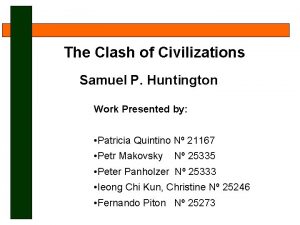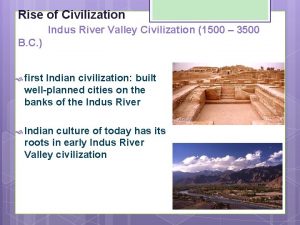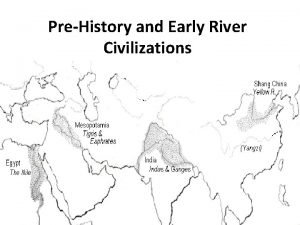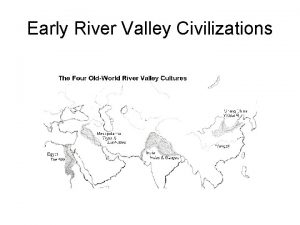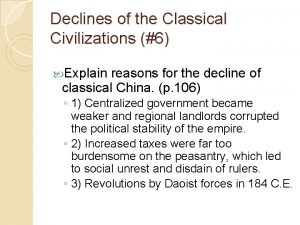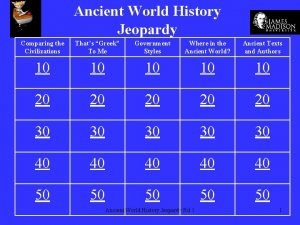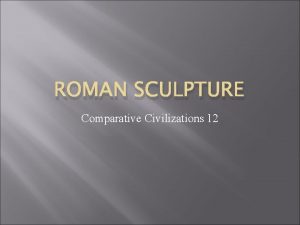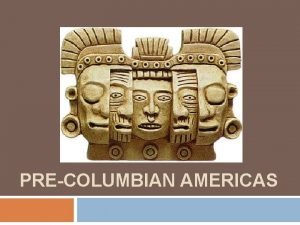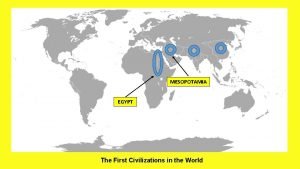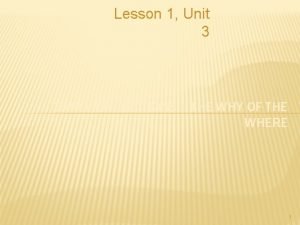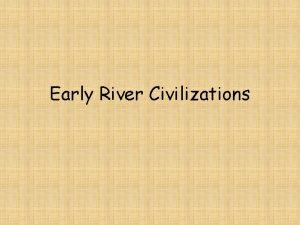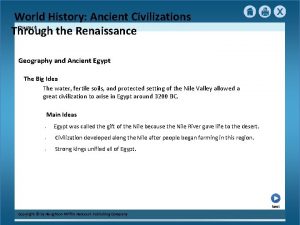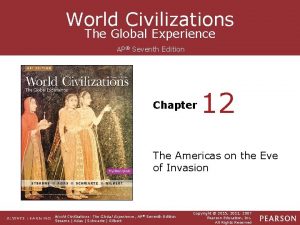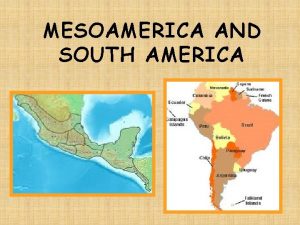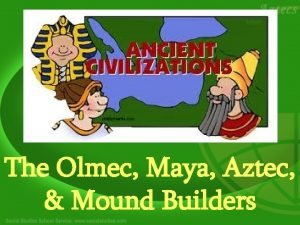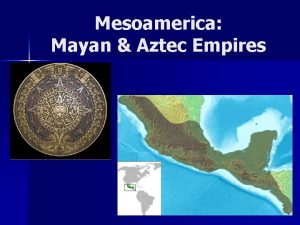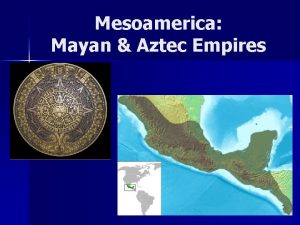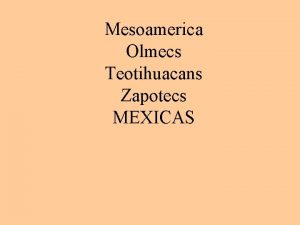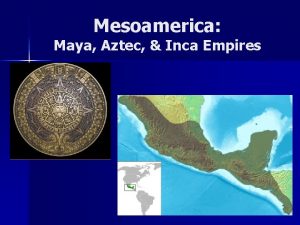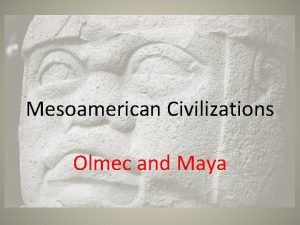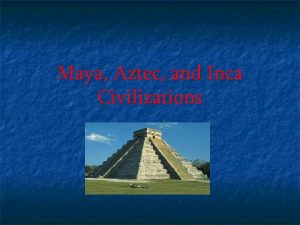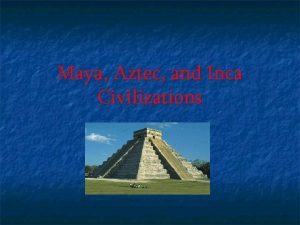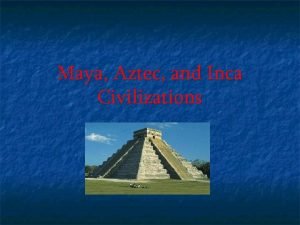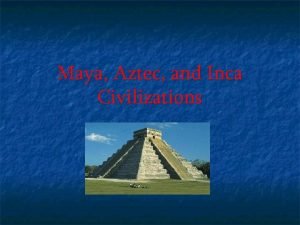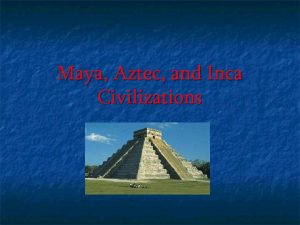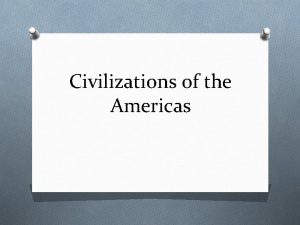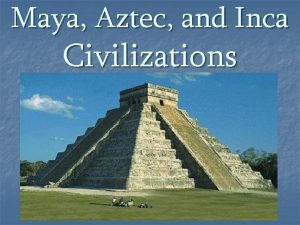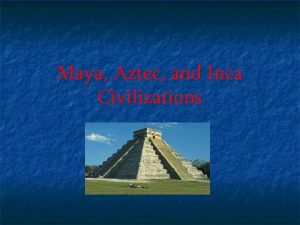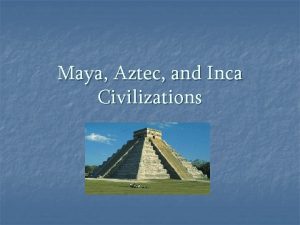CIVILIZATIONS OF AFRICA INDIA AND MESOAMERICA Unit 4




























































- Slides: 60

CIVILIZATIONS OF AFRICA, INDIA, AND MESOAMERICA Unit 4

Admit Slip 11/20 � Where is Africa? � What comes to mind when you hear the word Africa? � What type of geography do you think Africa has? � What is the benefit of living along the coastline?

Africa-Geography � � � Africa is the second largest continent in the world. Much of Africa is made up savannas, or grassy plains. Despite hot weather and occasional droughts, most spot have good soil ideal for farming. 40% of Africa is made up of deserts, the largest being the Sahara in Northern Africa. This desert acts like a geographic barrier and isolates people. Two other deserts that make up Africa include the Kalahari and the Namib Desert.

Africa-Geography � � � The savanna climate covers about 50% of Africa (area shaded in green) Most people and animals live here. Rainfall is unpredictable in these areas so droughts are common. Africa has many rivers, however the rivers in Africa have a lot of rapids and waterfalls. This causes many of the rivers in Africa to be difficult to navigate. Africa is well known for having an abundant amount of natural resources; most important being gold, oil, diamonds, and mineral deposits.

Trading Kingdoms of Africa Nubia � Kingdom of Nubia grew along the Nile River. � Kingdom of Nubia was also known as Kush. � Nubia had to often fight against Egypt for independence � However, as a result of this constant contact, Egypt and Nubia traded. � Despite the fighting, Nubia adopted many Egyptian ways. � This is an example of cultural diffusion.

Trading Kingdoms of Africa Ghana � Around 800 A. D. the rulers of many farming villages united to create the Kingdom of Ghana. � The King of Ghana controlled the gold and salt trade routes. � The Kingdom of Ghana came into contact with Muslim traders. � The King of Ghana was influenced by Muslim ideas about military technology and government. � The spread of Islam throughout Ghana is another example of cultural diffusion.

http: //www. history. com/shows/mankind-the-story-of-all-ofus/videos/salt

Trading Kingdoms of Africa Mali � Mali was another kingdom located in Western Africa � Mansa Musa was king of Mali, and was extremely powerful � Mansa Musa converted his people to Islam, and used the Koran as the basis for the legal system in Mali � Timbuktu became a major city involved in the gold trade, but also a major center of Islamic culture. � Mansa Musa completed the hajj, or pilgrimage to Mecca, which would be another example of cultural diffusion

https: //www. google. com/search? q=mali+kingdom&safe=acti ve&espv=2&biw=1280&bih=923&source=lnms&tbm=isch&s a=X&ved=0 CAYQ_AUo. AWo. VCh. MI_P 6 ysbady. QIVih. YCh 1 Cnwmc&surl=1#safe=active&tbm=isch&q=timbuktu

https: //www. youtube. com/watch? v=d 6 w. Ka. IEzx. Go

Trading Kingdoms of Africa Songhai � Important trading kingdom in west Africa � Controlled many trading routes. � Like Ghana and Mali, Songhai had contact with Muslims � The emperor of Songhai, set up a Muslim Dynasty � During this time Mosques and schools were opened up to study the Qur'an. � This is another example of cultural diffusion.

India-Geography � � � India is classified as a subcontinent A subcontinent is a landmass that juts out of another landmass. India juts out of Asia. The Himalayan Mountains are located in Northern India. Includes the tallest mountain range in the world; Mount Everest. Separates the Indian subcontinent from Asia

India-Geography � � The Indian Subcontinent is home to many important rivers as well. The Indus River begins in the Himalayas, and was the location of earliest form of civilization in region. The Ganges River is located in Central India, and is holy to the followers of Hinduism. Both rivers provide fertile soil ideal for farming.

India-Geography Deccan Plateau � High, flat land in � Very few people here � Dry Climate India live https: //www. google. com/s earch? q=seasonal+winds +in+india&source=lnms&t bm=isch&sa=X&ei=d. Gm. K Urq. NCIius. AS_r 4 DIAg&ve d=0 CAc. Q_AUo. AQ&biw=1 280&bih=930#q=deccan+ plateau+images&tbm=isc h&imgdii=_

Monsoons � � � Monsoons were seasonal winds that would bring about extreme weather. Summer monsoons (wet), blow over water, bringing wet weather for the farmers. Winter monsoons (dry), blow over land, and bring dry weather.


MESOAMERICAN CIVILIZATIONS

Geographic Setting � � The first great American civilization developed in Mesoamerica (also called Middle America) The region includes Mexico and Central America.


Olmecs � � � The Olmec Empire, which lasted from 1400 BC to 500 BC, was the first major American Civilization. It emerged in the tropical forests along the Gulf of Mexico. Instead of cities, the Olmecs built ceremonial centers made up of pyramid-shaped temples and other buildings. The Olmecs invented a calendar and developed a system of writing made up of carved inscriptions. Greatest advancement was their devotion to religion and their priests. Olmec religion and writing were later copied by later Mesoamerican civilizations.

Olmec Writing and Religion

Mayas � � � One major civilization influenced by the Olmecs was the Mayas, who flourished between AD 300 to 900. During this period, the Mayas developed a complex agricultural society. They established large city-states in southern Mexico and Central America.

Farming and Trade � � � Farmers made up most of the Mayan population. Men cultivated the crops, which included; maize, beans, and squash. Women were in charge of turning these crops into food. Farmers paid taxes, in the form of food, to support the cities and their temples. The Mayas benefited from profitable trade Goods traded include; honey, cocoa, and feathers

Mayan Farming � https: //www. google. com/search? q=mayan+far ming&safe=active&biw=1600&bih=799&source =lnms&tbm=isch&sa=X&ved=0 CAc. Q_AUo. AW o. VCh. MIir. P 7 m 6 y. Yy. QIVw. ZMe. Ch 1 sl. Qe. X&surl=1

Religion � � � Because of the importance of religion in Mayan civilization, priests were held in high regard. These religious leaders were held in such high regard because they were responsible for conducting elaborate rituals. These rituals were thought to bring about bountiful harvests and victories in battle. The importance of religion to the Mayas may be judged from their size of their temples. Priests climbed these tall structures while the common people watched from ground level.

http: //www. history. com/topics/maya/videos/seven-wonders-the-temple-ofchichen-itza



Social Structure � � � Mayan civilization featured a distinct social hierarchy. Each Mayan city-state had its ruling chief. Below the chiefs were the nobles, who served as city leaders and military generals. Although those in the ruling class were usually men, women could gain power as well. The majority of the Mayan population were farmers.

Contributions � Architecture � In their cities, Mayas built giant pyramid temples and large palaces. � Elaborate cave paintings and carvings on walls depicted events from Mayan history. � Agriculture � Despite the tropical environment, the Mayas grew enough food to support large populations. � Farmers made this possible by clearing out the dense rain forests and then building raised fields that were capable of holding and draining water.


Contributions � Learning and Science � Mayas were known for their advanced learning. � Developed a hieroglyphic (picture) system of writing and recorded much of their history in books made of bark. � Mayan priests developed a very accurate 365 - day calendar. � They also used numbering systems and understood the concept of zero before Europeans did.


http: //www. history. com/topics/maya

Aztecs � � In the late 1200’s, a nomadic group migrated from the north into the valley of Mexico. They settled in an area known as Tenochtitlan, which later became their capital. In the 1400’s the Aztecs used military conquests and alliances to grow their empire. Their capital became a magnificent city with temples, palaces, gardens and zoos.

Aztec Expansion � � � After the founding of Tenochtitlan, the Aztecs began to form alliances with neighboring cities. This act caused the Aztec Empire to grow. Through a series of military conquests, the Aztecs became the leading power in Central America. Aztecs forced conquered nations to pay tribute, or money to the empire. This resulted in the Aztec Empire becoming rich.

Social Hierarchy � � � Unlike the Mayas, the Aztecs were ruled by an emperor. Below the ruler, were the nobles and priests. Warriors came next and were highly respected in Aztec civilization. Traders comprised the rest of the middle class. Most of the people in the empire were farmers. Slaves made up the lowest class in Aztec civilization (more rights than usual).

Religion � � � Religion was vital to the Aztecs Priests in Aztec civilization were known for conducting complex rituals and sacrifices to appease the gods. Aztec civilization believed these sacrifices (human) would prevent disasters from occurring. These sacrifices took place at the huge pyramid built in the center of Tenochtitlan to honor their chief god, the sun god. The Aztecs usually sacrificed enemy soldiers who were captured in battle.



Contributions � Learning and Science � Aztec priests devised an accurate calendar � They established schools and recorded historical events. � Aztec medical practices were advanced enough that practitioners could set broken bones and treat dental cavities. � Architectural and Engineering � Capital at Tenochtitlan was one of the grandest cities in Mesoamerica. � Started as two islands in the middle of Lake Texcoco. � Engineers built wide stone causeways to connect Tenochtitlan to the mainland. � Architects built temples, palaces, and pyramids



Contributions � Farming � The Aztecs are remembered in history on how they adapted to their environment to farm. � The used a variety of fertilizers and converted swampy areas into productive farmland. � They built chinampas, or “floating gardens”, made up of earth piled on reed mats that were anchored to the shallow bed of Lake Texcoco. � On these floating gardens, Aztecs grew corn, squash, and beans. � Aztecs were able to grow a surplus of food


https: //www. youtube. com/watch? v=AIC_f. St _-xw https: //www. youtube. com/watch? v=9 ay 78 b Cw. Xe 8

http: //www. history. com/topics/aztecs

Incas � � � In the 1400 s, the Incas emerged from the Andes Mountains. The Andes Mountains is a large mountain chain running along the west coast of South America. The Incas are known for adapting to their environment in order to survive.


Centralized Government � � � Like the Aztecs, the Incas were ruled by an emperor. The emperor held absolute power and also was the leader of many military conquests to attain more land. The emperor also was the chief religious leader and clamed divine status as the son of the sun. The emperor headed a strong central government from the mountain capital of Cuzco. Nobles and governors ran the smaller provinces surrounding the capital by collecting taxes and enforcing laws, and then were responsible for reporting back to the emperor.

An Empire Linked by Roads � � � The emperor could have imposed his centralized rule over such an area without a remarkable system of roads. Runners used the roads to carry information and citizens/military could easily travel throughout the empire. Roads, bridges, and tunnels also helped encourage trading and commerce throughout the empire.



Incan Religion � � Incan religion affected all parts of daily life. The people worshiped many gods related to the forces of nature. The chief deity of the Incas was the sun god. A powerful class of priests conducted rituals and led monthly religious festivals that featured sports and games.

Contributions � Engineering and Architecture � The Incan system of roads stretched 12, 000 miles, included hundreds of bridges, and even used tunnels and steps to pass through mountainous terrain. � The capital city of Cuzco was home to the massive temple dedicated to the Sun God- Temple of the Sun � The temple walls were lined with gold and could even withstand earthquakes.


Contributions � Farming � Like the Aztecs, the Incas were remembered on how they adapted to their environment in order to farm. � The Incas lived in the Andes Mountains where they utilized a form of agriculture called terrace farming. � Farmers used stone walls to improve upon these terraces which helped hold the land in place. � The hills were extremely steep, so the terraces would prevented the rain from washing away the soil. � Terraces made farming possible in places where flat land was scarce.


Contributions � Communication � Incan government kept accurate records by means of a system of knotted, colored strings called quipus. � Historians believed that quipus may have been used to record dates, events, crops statistics, and population. � Science � Incas had a calendar but not as advanced as the Mayas. � The Incas excelled in medicine by performing successful surgery and had great knowledge of medicine and diseases.

https: //www. google. com/search? q=inca+sp orts&safe=active&espv=2&biw=1280&bih= 923&source=lnms&tbm=isch&sa=X&ved=0 CAYQ_AUo. AWo. VCh. MI 4_y. Pm. O 6 ay. QIVyf MCh 3 QPAPD&surl=1#safe=active&tbm=isch &q=quipus+inca+empire http: //www. history. com/topics/inca/videos/ machu-picchu
 Civilizations of mesoamerica
Civilizations of mesoamerica Chapter 11 section 1 early civilizations of africa
Chapter 11 section 1 early civilizations of africa Ancient india lesson 1 early civilizations
Ancient india lesson 1 early civilizations The two classical civilizations of ancient india were the
The two classical civilizations of ancient india were the Chapter 14 pre columbian america answers
Chapter 14 pre columbian america answers The peoples of north america and mesoamerica
The peoples of north america and mesoamerica Geography of mesoamerica
Geography of mesoamerica What is the climate like in mesoamerica
What is the climate like in mesoamerica Terrace farming mesoamerica
Terrace farming mesoamerica Mesoamerica inca
Mesoamerica inca Inca vs maya
Inca vs maya Mesoamerica inca
Mesoamerica inca Society
Society Paises que componen mesoamerica
Paises que componen mesoamerica Climate of mesoamerica
Climate of mesoamerica Mesoamerica culturas
Mesoamerica culturas El arte precolombina
El arte precolombina Mesoamerica powerpoint
Mesoamerica powerpoint Mesoamerica vocabulary
Mesoamerica vocabulary Teotihuacanos mayas y zapotecos
Teotihuacanos mayas y zapotecos Aztecs incas and mayans map
Aztecs incas and mayans map Unit 10, unit 10 review tests, unit 10 general test
Unit 10, unit 10 review tests, unit 10 general test Yellow river civilization map
Yellow river civilization map Ancient river valleys map
Ancient river valleys map Early south american civilizations
Early south american civilizations Scholargentry
Scholargentry 4 river valley civilizations
4 river valley civilizations Mayan vs aztec vs inca timeline
Mayan vs aztec vs inca timeline 3,500 bce
3,500 bce 4 river valley civilizations
4 river valley civilizations What is believed to be the 1 stdynasty of ancient china?
What is believed to be the 1 stdynasty of ancient china? Second wave civilizations
Second wave civilizations Mediterranean civilizations location hemisphere
Mediterranean civilizations location hemisphere What was the significance of the metric act of 1866
What was the significance of the metric act of 1866 World civilizations the global experience ap edition
World civilizations the global experience ap edition World civilizations the global experience 7th edition
World civilizations the global experience 7th edition What are 7 characteristics of a civilization
What are 7 characteristics of a civilization What are 6 characteristics of civilization
What are 6 characteristics of civilization Which cultures believe in reincarnation
Which cultures believe in reincarnation Topic 3 review questions civilizations of asia answers
Topic 3 review questions civilizations of asia answers River valley civilizations def
River valley civilizations def Civilization ppt template
Civilization ppt template Third wave civilizations time period
Third wave civilizations time period Where did the earliest civilizations develop
Where did the earliest civilizations develop Artifact คืออะไร
Artifact คืออะไร Conclusion of civilization
Conclusion of civilization Clash of civilizations huntington
Clash of civilizations huntington Indus river valley timeline
Indus river valley timeline River valley civilizations map
River valley civilizations map River valley civilizations vocabulary
River valley civilizations vocabulary Code of hammurabi
Code of hammurabi What caused the decline of classical civilizations
What caused the decline of classical civilizations World history jeopardy
World history jeopardy Indus river valley job specialization
Indus river valley job specialization Comparative civilizations 12
Comparative civilizations 12 Pre columbian civilizations
Pre columbian civilizations First civilizations
First civilizations Lesson 1 early civilizations
Lesson 1 early civilizations River valley civilization
River valley civilization Ancient civilizations through the renaissance
Ancient civilizations through the renaissance Twantinsuyu
Twantinsuyu
